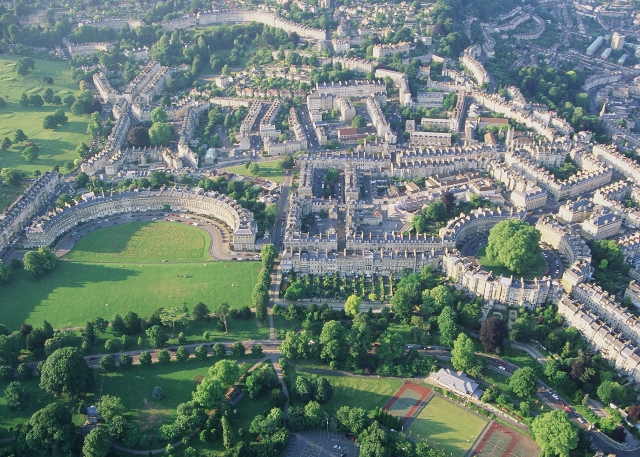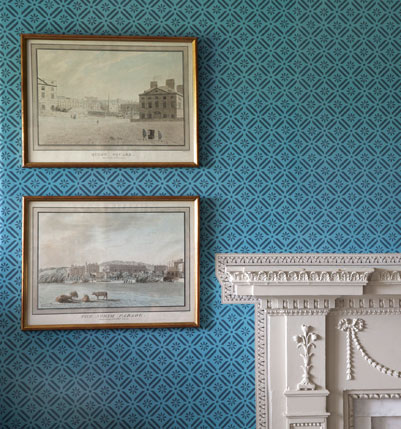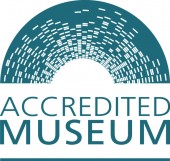Henry Sandford was the first resident of No. 1 Royal Crescent. He lived at the house from 1776 until his death in Bath in 1796. Recent research has greatly improved our understanding of who Henry Sandford was and how he might have lived in No.1 Royal Crescent and the interpretation of the museum has used these details to bring the house to life.
Henry Sandford was born on 30th December 1719 in Castlerea, County Roscommon, the eldest son of Robert Sandford Esq. and his wife Henrietta who went on to have 6 more children, one son and five daughters. The Sandford family had settled in Ireland after being granted lands in the county in 1666 for services to the crown during the Civil War and had become highly respected and wealthy landowners. They established themselves through making important connections with local noble families; Henry’s mother was the daughter of the 3rdEarl of Inchiquin and Henry himself married the daughter of the 1st Viscount Mountcashel, Sarah Moore, in 1750. Henry was clearly educated with a view to politics. He attended Trinity College, Dublin, from 1736-37 and in 1741 became an MP for County Roscommon, a post which he held for the next 19 years. In 1761 he was returned for the county of Kildare and in 1768 for the county of Carrick (which no longer exists). He held this post until 1776.
Henry and Sarah had 5 children: Henry Moore (‘Harry’), William, Harti, George and Louisa.
Sarah died in 1764 and Henry, after increasingly poor health forced him to take a back seat in political affairs, moved to Bath in 1776, presumably because of his health and took up residence at No.1 Royal Crescent. By this time his eldest son was 25 and old enough to assume the responsibility of managing his father’s estate.
Henry Sandford’s real wealth and yearly income can only be guessed at, but we know that he was wealthy enough to lease a house in Bath’s most prestigious location. Fellow residents included the Duke of York and Elizabeth Montagu, one of England’s richest women. It appears that his primary income came from land rentals rather than from agriculture itself. A marriage settlement given to him by his father in 1750 contained the rent rolls of roughly 60 tenants, with the net rent for one year being 760 pounds,10 shillings and 6 pence, (roughly £68,000 in today’s money, and this presumably was not the total value of the estates). When the second Baron Mount Sandford died in 1828 the entirety of the estates was estimated at £15,000 (roughly £750,000 in today’s money). This suggests that the Sandfords were comfortably off rather than excessively wealthy.
Henry Moore presumably took over the running of his father’s estates after the latter’s move to Bath, and he wascreated first Baron Mount Sandford in 1800. He and his wife Catherine died childless, so the title passed to his nephew Henry, son of his brother the Reverend William. Henry, the second Baron, was killed in a riot at Windsor in 1828 and the title moved back a generation to his uncle George Sandford, who was the third and last Baron Mount Sandford.
The Will
Sandford’s will primarily divided his estate outside Castlerea between his second son William and his third son George. Little mention is made of Henry Moore at all, other than a settlement of £3,000 for his own personal use, suggesting that he had either already taken charge of the Castlerea estate or had been left lands by other family members, or that by default the remainder of the lands not mentioned in Sandford’s will passed to Henry. A rift is unlikely, as he mentions Catherine Sandford in two codicils as caring for him in his ‘late and present illness.’ Sandford also seems to take his responsibility as head of his family seriously, and leaves money to his (presumably) surviving sisters Rachel and Henrietta, his daughter Louisa, as well as two of his nieces Mary Fortescue and Harriet Douglas (daughters of his sisters Anne and Henrietta respectively). He also leaves a list of annuities to be paid, presumably to servants, including the ‘wood ranger’ and ‘gatekeeper’ (seemingly for his Castlerea estate).
The Will shows us how much land he owned at the time of his death and where it was. He had land in ‘baronies of Roscommon and Ballintobber’ as well as ‘400 acres of profitable land situated in the County of West Meath’ and also ‘several houses and premises in the city of Dublin.’
Bath and the Commonplace Book
We know that Sandford began paying city rates from 1776 for No.1 Royal Crescent and we know that he died at No.1 in 1796, but other than this we know very little about Sandford’s time in Bath.
Minutes of the AGMs of the Bath and West Agricultural society show that he attended meetings from 1778 to 1780.
Sandford’s Commonplace Book has provided us with some clues as to his interests and how he passed his time in Bath. Commonplace books were used almost as a scrapbook, compiling interesting facts and figures, newspaper cuttings of current events, but hardly any personal information.
Bath Scandal and Gossip
As he became an established resident Sandford clearly made friends – and enemies! The second volume in particular has lots of references to local scandals, a doctor’s liason with a wealthy widow, the dispute over who would become the next Master of Ceremonies in the lower assembly rooms, an uproarious party thrown at the Crescent… Many of these take the form of newspaper cuttings, supposedly anonymous, in which Sandford has annotated the blank spaces with the names of the people involved! Sandford also features several local characters in a collection of rather rude poems and appeared to enjoy making fun of his neighbours. His references to conversations with other Bath residents seem to centre on Captains, Colonels, Doctors etc., showing that he moved very much in a middle class, professional gentleman’s circle.
Agriculture
This is probably the largest topic mentioned in the commonplace book. Bath was an important centre for agriculture as it was so close to the countryside, and the formation and popularity of the Bath and West Agricultural society shows the fascination that was growing around agricultural production as the agricultural revolution began to increase production and revolutionise farming methods.
Sandford’s observations on agriculture often centre around livestock – the size of animals, how many were owned by a particular farmer etc., but are not limited to this. He was interested in transport and through his observations we can see that produce was moving much more quickly around the country than it had done so previously. At a time when crop yields began to grow and different types of produce were being planted, Sandford’s numerous observations on crop production, which may seem mundane to us today, demonstrate a topic that was at the forefront of agricultural developments and that farmers were beginning to experiment :‘a field of Barley and Oats in the parish of Wishaw belonging to farmer Walker was sown the 2nd June 1782 and reap’d the 21st Dec following. The Barley was remarkably good, the oats indifferent.’ (Vol.2, p157)
Travel
From certain accounts written as a first-hand experience, we can glean from the commonplace book that Henry travelled widely in Scotland and the North of England, as well as in Northern Europe, in Holland, Germany and Belgium. He clearly missed out on the ‘Grand Tour’, whether this was due to a lack of funds or a disinclination to travel further into France and Spain is not clear, but it is clear from his observations on a number of popes ‘leading the most scandalous and profligate lives’ that he had a sincere dislike for the Catholic church, so this could possibly account for it. He does, however, make a lot of references to the industries of both countries throughout both volumes.
Science and learning
In some ways it seems that Sandford was very much a gentleman of the enlightenment. This was a time when knowledge was being pursued, collated and quantified, publications detailing the latest advances in science, agriculture, industry appeared everywhere, one of the most popular being the Gentleman’s Magazine (founded 1731). The opening of the British Museum in 1753 followed by the expeditions of Captain Cook and Joseph Banks in the late 1760s/early 1770s, patronised by the Royal Society, served to expand people’s knowledge of the world and of different peoples and places across the globe. There are references to articles in theGentleman’s Magazine throughout the commonplace book so we can assume that Sandford was a regular reader. He also appeared to follow the publications of the Royal Society and makes frequent references to the voyages of Captain Cook as well as the geological publications of Sir William Hamilton during his travels in the bay of Naples. ‘During the Eruption of Mount Vesuvius in August 1779 stones of 2 ounces weight were carred to several places…Sir William Hamilton’s Account.’ (Vol II, p116)
History, Art and Warfare
Sandford was clearly interested in Classical history and the commonplace book is full of accounts of Roman emperors, Greek philosophers, ancient Egyptian rulers and so on, although he was primarily concerned with what they built and how much it cost! Reference to warfare in any form is extremely limited. Although Roman influences had been around for years Greek Art and sculpture were only really re-discovered in the late 18thcentury, but it receives scant attention here. Clearly Sandford was not much interested in the arts.
Law
Sandford’s position as landlord of a number of different estates seems to have influence his interest in law and politics. References to poor rates, number of houses in certain areas, incomes of the nobility of France and England etc show that he was a man responsible for a number of tenants and property maintenance. Volume II contains some accounts of differences in the laws between England and Scotland, and also some newspaper accounts of court martials and other trials.
Links
Tom Wills-Sandford, Henry’s five times great grandson and the only direct male descendant, and Tom’s cousin Michael Sandford have given us considerable help in researching Henry’s life. This research, including information about Theophilus Sandford, Henry’s Great Grandfather, who established the family in Ireland, can be found here





